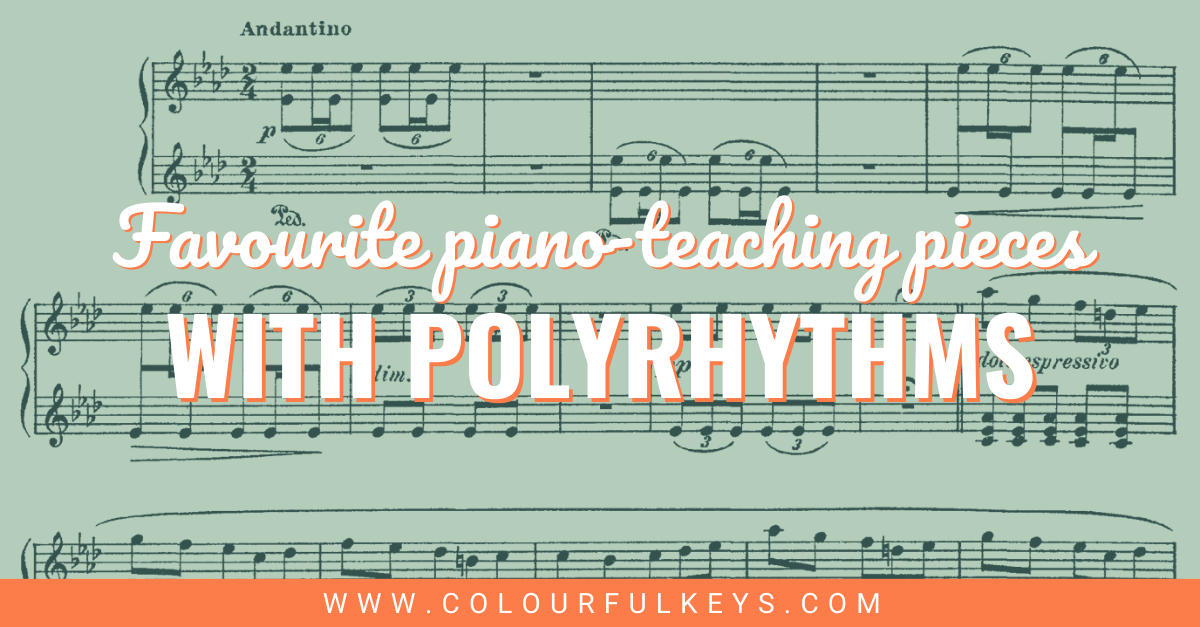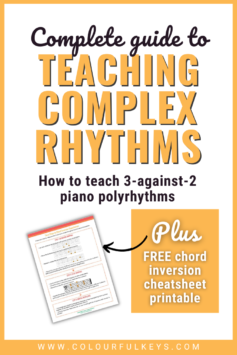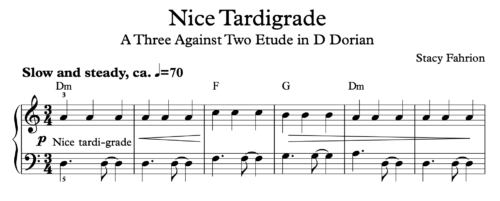
This article about how to teach piano polyrhythms was written by Stacy Fahrion. Stacy is a composer, pianist, educator and perpetual student based in Colorado, USA. Their music – including both whimsically macabre arrangements and original pieces – can be viewed and listened to in the Piano Pronto Composers Community. Their more recent music is often post-minimal and uses alternate tuning systems. Find out more about Stacy and whatever new thing they’re up to at their website, Whimsically Macabre, or by subscribing to their YouTube channel.
Teaching polyrhythms is one of the best ways to help your piano students feel subdivisions and improve their overall rhythmic accuracy and control. Once pianists understand and internalise what some of the common polyrhythms sound like, they’ll be much less intimidated (and possibly even excited!) when they encounter them in repertoire.
But are you too intimidated to teach piano polyrhythms?

Feeling 3 notes against 2 can require some serious coordination – but once your student gets it, there’ll be no stopping them.
Don’t worry: Teaching these rhythms doesn’t have to be hard or scary. Here’s my 3-step method for teaching one of the most common polyrhythms: 3-against-2.
3 Steps to Polyrhythmic Playing
As with anything complicated, breaking down polyrhythms to their most basic level first is the key to success.
Step 1: Clapping and Patsching
Begin by getting your student used to how these polyrhythms feel and sound before adding in the complication of the piano.
Steady Beat
Have your student clap steady quavers (eighth notes) while counting “ONE and two and three and” with a strong emphasis on beat 1.
Change up the Clapping
Next, keep saying “ONE and two and three and”, but this time they only clap on the words in bold.
Switch to Patsching
While your student continues chanting and clapping, demonstrate the next step by patsching (tapping hands on knees/lap) both hands on “one,” then tap right-left-right when you say “two and three.” It should look and sound something like this:
| ONE | and | two | and | three | and |
| both | right | left | right |
Have your student imitate you, and yipee! 🥳 You’re both tapping 3-against-2!
Once the rhythm feels secure, students can use the mnemonic “not dif-fi-cult” or “hot cup of tea” if it helps them remember the feel of the rhythm. If you have a student who particularly loves quirky phrases, you might even try the phrase “nice tar-di-grade.”
| ONE | and | two | and | three | and |
| both | right | left | right | ||
| not | dif- | fi- | cult | ||
| hot | cup | of | tea |
Step 2: Improvising
Once students can accurately tap the polyrhythm, try a structured two-finger improvisation that uses 3-against-2 over and over again.
Pick any 5-note pattern or pentascale, and limit your student to using only finger 2 in each hand. The left hand plays repeated tonic notes, while the right hand can move around and play any notes from the 5-note pattern.
For example, if your student chooses A-minor, the left hand would play a repeated A while the right hand can move around, playing any notes from the A-minor pentascale.
I suggest setting a timer for 3 minutes and having the student hold down the damper pedal throughout.
Step 3: Composing
As a composer, I strongly believe that one of the best ways to internalise any new concept is through composing. Ideally, students both compose a piece of their own, and simultaneously learn a piece that uses this rhythm.

Want to take your students’ chord skills to the next level? Create chord inversion superheroes with this cheatsheet. Enter your info below for a free copy.

Subscribe to updates and get the chord inversion cheatsheet
Enter your details to subscribe to the newsletter for piano teachers with information, tips and offers.
I hate spam as much as you do! I’ll only send you information that’s directly relevant to music teachers and you can unsubscribe at any time.
If you’re a member of Nicola’s amazing Vibrant Music Teaching program, you can download the cheatsheet right now from the printable library. Not a member? Whoa, you don’t know what you’re missing! Check it out at vibrantmusicteaching.com.
Polyrhythmic Repertoire
Now that 3-against-2 is learnt and internalised, let’s explore this in the repertoire. Here are some of my top suggestions for those looking to teach piano polyrhythms.
Late Beginner
It can be a little tricky to find beginning pieces with polyrhythms – so I came up with my own!
- Stacy Fahrion: Nice Tardigrade
Remember: At any stage of learning, improvisation and composition are perfectly valid ways to explore polyrhythms if you can’t find suitable pieces.
Intermediate
Since polyrhythms require good coordination and experience at the piano, you’ll find more material starting at this level.
- Joanne Griffiths: Clocks (great for ledger line work)
- Klaus Badelt: He’s a Pirate
- I sometimes use the arrangement in FunTime Piano Popular
- There’s also a good arrangement by Jennifer Linn
- Max Richter: H in New England (my favourite minimalist piece to teach)
- Philip Glass:
- Stacy Fahrion:
Advanced
And here are my favourites for late-stage pianists looking for a challenge!
- Amy Beach: Cradle Song of the Lonely Mother, Op. 108
- Camille Saint-Saëns: Étude de Rythme in A-flat, Op. 52, No. 4
- Claude Debussy: Arabesque I
- Frédéric Chopin’s Nocturnes:
- Edvard Grieg: Notturno, Op. 54
- Fanny Mendelssohn-Hensel: Four Lieder for Piano, Op. 6, No. 1 in A-flat Major
- Felix Mendelssohn: Lieder ohne Worte, Op. 85, No. 1 in F Major
- Florence Price: Fantasie Negre No. 2 in G minor
- Philip Glass: Étude 6, Book I
- Sergei Bortkiewicz: Prelude, Op. 6, No. 1 in E-flat minor

Go forth and teach 3-against-2!
I challenge you to teach 3-against-2 polyrhythms to at least 1 of your beginner piano students this week, encouraging them to improvise with it for a couple of minutes. Share your experience in the comments below. 🙂
If you liked this post, you’ll love the resources found on the Colourful Keys page devoted to all-things-teaching-music-theory.
